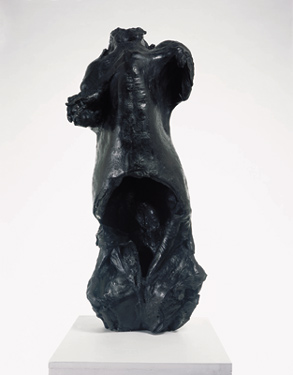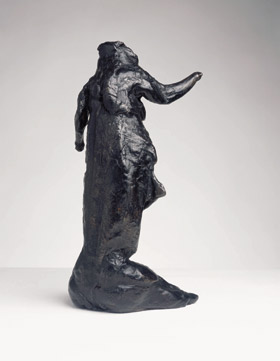 |
| Marc Quinn, Torso (stag), 2004; courtesy Mary Boone Gallery, New York / Irish Museum of Modern Art |
In the infamous Sensation exhibition at the Royal Academy of Arts in 1997, Marc Quinn exhibited a perspex sculpture, cast from his head and filled with his own blood. Whilst the materials and subject matter Quinn has subsequently used have sometimes provoked controversy, the ideas he explores are the great themes of art and literature: immortality, death and what it is to be human. Flesh , Quinn’s first solo show in Ireland, continues this exploration with fourteen new works cast in bronze with a black patina, moulded from freshly slaughtered animal carcasses.
Quinn is by no means the first artist to use the carcasses of animals within his work. Painters such as Chaim Soutine and Francis Bacon used the carcass as a way of exploring man’s mortality. Quinn takes a slightly different approach, using the carcass directly, creating poses that reference traditional figurative sculpture such as torsos or reclining nudes.
 |
| Marc Quinn, Seated figure (bull), 2004, bronze; courtesy White Cube, London / Irish Museum of Modern Art |
In Seated figure (bull) (2004), a gigantic, headless and limbless bull sits on a white plynth. The remnants of a rope hangs around its neck. Its fur is matted with blood, tendons bulging through gaping flesh. Despite the grimness of subject matter, the overwhelming impression created is one of awe rather than pity. Quinn’s use of bronze transforms this potentially pathetic image into something monumental and heroic.
 |
| Marc Quinn, Standing figure (rabbit), 2003; courtesy Jay Jopling/White Cube, London / Irish Museum of Modern Art |
Smaller works cast from rabbits take on a Rodin-like elegance. From certain angles they could be mistaken for reclining human figures; the stumps of their necks appear like small heads. At other angles, their skin falls like cloth, revealing glimpses of innards. This ambiguity of form brings to mind Bacon’s assertion that “we are meat. We are potential carcasses." However, Quinn’s interpretation is less bleak, his sculptures containing a quiet dignity. He has said:
Somehow all life is the same. All life has the same origin. It has to because there is nowhere else for it to come from. Human beings are very grand and think they’re above everything but in fact we’re connected to everything else. [1]
You might think that an exhibition of carcasses could be enough to turn you to vegetarianism; however, Quinn has created something extraordinary with this series of works. Reduced to black on white, we are removed from the violence and indigity of the slaughter and left with sculptures which are strangely uplifting.
Jacqui McIntosh is a freelance writer based in Dublin.
[1] Marc Quinn, Incarnate, in A Universe of Opposites, p. 52